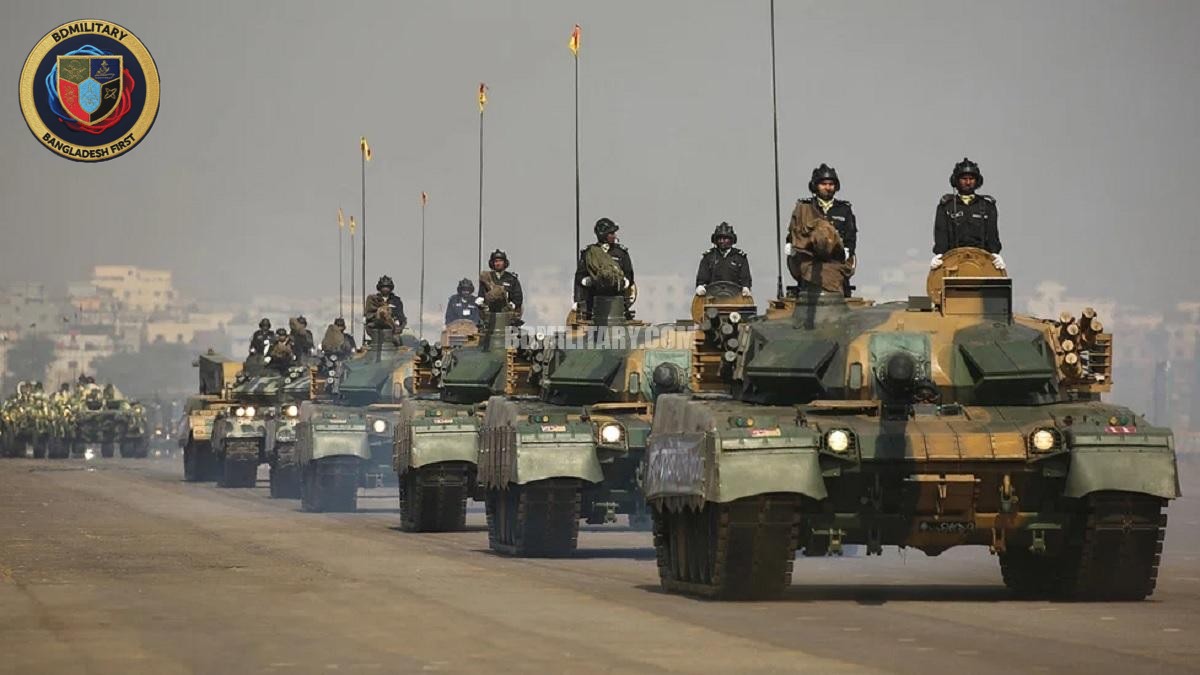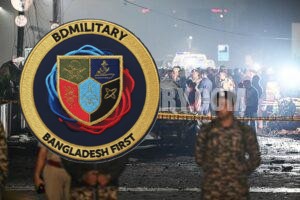Bangladesh occupies a unique and strategically sensitive position in South Asia. With a dense population, a long riverine and coastal frontier, and a complex regional security environment, the country faces multiple challenges that demand a capable and modern military. Despite these pressures, Bangladesh continues to spend significantly less per capita on defence than its primary regional peers. Estimates suggest that Bangladesh allocates approximately USD 23 per person annually for defence, compared with USD 59 for India and USD 40 for Pakistan. This discrepancy is not merely a numerical anomaly; it reflects a persistent underinvestment in national security. The question that arises, therefore, is not whether Bangladesh could spend more on defence — it clearly can — but rather how it can do so effectively, sustainably, and strategically.
At present, Bangladesh devotes roughly 1.1–1.2 per cent of its GDP to defence, representing a fraction of both the total government budget and the proportion of GDP spent by regional counterparts. Defence expenditure constitutes only 5–6 per cent of the national budget, indicating that resources devoted to military readiness and capability development remain limited. Yet, the country’s macroeconomic fundamentals provide scope for higher spending. Public debt levels are moderate, estimated at 38–41 per cent of GDP, and revenue mobilisation remains underdeveloped, with a tax-to-GDP ratio of approximately 7–8 per cent. This structural fiscal potential indicates that the country can, if it so chooses, allocate more resources to its armed forces without endangering macroeconomic stability. Importantly, such an increase should not be seen as an optional luxury, but as a strategic investment in sovereignty, deterrence, and national resilience.
To ensure that increased spending yields tangible improvements in capability, Bangladesh requires a comprehensive strategy that combines fiscal innovation, procurement discipline, industrial development, and institutional strengthening. The first pillar of this strategy must address fiscal reform and budgetary innovation. Improving revenue mobilisation is a critical starting point. Bangladesh’s low tax-to-GDP ratio suggests significant untapped potential. Measures such as broadening the value-added tax (VAT) base, increasing income tax compliance, and reducing unnecessary exemptions could generate several billion dollars annually, providing a sustainable source of funds for defence expenditure. Equally important is the introduction of multi-year defence budgeting, which would allow the armed forces to plan acquisitions and capability upgrades over three to five years, reducing inefficiencies inherent in single-year, ad hoc budgeting cycles.
In addition to revenue mobilisation, innovative financing mechanisms can play a critical role. The government could establish Defence Bonds, offering long-tenor, low-interest securities targeted at institutional investors such as pension funds and state-owned banks. These bonds would provide a dedicated funding stream for major capital acquisitions, mitigating the strain on annual budget allocations. Complementary to this, Bangladesh could leverage supplier-credit arrangements or concessional foreign loans for major acquisitions, thereby easing immediate foreign-exchange pressure. Finally, the establishment of a Defence Stabilisation Fund, a form of contingency reserve, would allow the military to absorb procurement peaks without causing sudden budgetary stress, ensuring a smooth and predictable flow of resources for capability development.
The second pillar of a sustainable defence strategy involves capability-driven procurement and spending efficiency. Simply increasing expenditure is insufficient if it is not directed towards priority capabilities. Bangladesh must undertake a disciplined assessment of its strategic gaps and allocate resources accordingly. Current assessments suggest that maritime domain awareness, air-defence systems, and command, control, communications, computers, intelligence, surveillance, and reconnaissance (C4ISR) capabilities should be treated as top priorities. By focusing on capability packages rather than individual platforms, the armed forces can achieve operational effectiveness while avoiding the pitfalls of ad hoc acquisitions.
Furthermore, each procurement decision should incorporate lifecycle cost analysis, evaluating not just the upfront purchase price but also long-term maintenance, training, and operational costs. Such an approach ensures that platforms remain serviceable and do not become financial burdens over time. Competitive and transparent contracting procedures, coupled with independent oversight, will also be vital in mitigating corruption and inefficiency. Regional cooperation and joint procurement with friendly states may offer additional cost savings, particularly for items such as naval vessels or unmanned aerial systems, by enabling economies of scale and pooled support arrangements.
While prudent fiscal policy and procurement discipline are essential, the most transformative element of Bangladesh’s defence strategy lies in the development of a Defence Economic Zone (DEZ) dedicated to research, development, and indigenous production. Establishing such a zone would not merely facilitate procurement; it would fundamentally enhance national security by reducing reliance on foreign suppliers and building domestic technological capabilities. The DEZ should be located near existing military-industrial infrastructure and designed to encourage public-private partnerships, joint ventures, and foreign direct investment, with fiscal and regulatory incentives for technology-transfer initiatives.
Central to the DEZ’s mission should be a focus on R&D. A dedicated defence research institute could coordinate innovation in areas such as drones, unmanned vessels, electronic warfare, cyber capabilities, and advanced munitions. Collaborations with universities, technical institutes, and private-sector firms would stimulate innovation while ensuring that research outcomes are translated into deployable capabilities. Beyond R&D, the DEZ should emphasise indigenous production. From small arms and ammunition to patrol craft, unmanned systems, and critical electronics, local manufacturing capacity must be developed to gradually achieve self-reliance. All foreign procurements should be accompanied by offset agreements and technology-transfer conditions to ensure progressive localisation of defence production. In addition, the DEZ should incorporate export-oriented strategies, enabling Bangladesh to produce cost-effective products for regional and global markets, thereby generating revenue to further support capability development.
The fourth pillar of a sustainable defence strategy involves institutional strengthening and good governance. Increased spending and industrial capacity will only yield results if supported by effective institutions. Transparency in budget allocation, public reporting of non-sensitive defence programmes, and parliamentary oversight are essential to maintaining legitimacy and public trust. Strong auditing mechanisms, e-procurement systems, and forensic financial controls can reduce corruption and mismanagement. Equally important is the development of human and logistic capacity. Investment in training, maintenance, and depot infrastructure will ensure that new platforms remain operational and capable, avoiding the decay that often afflicts militaries with low operating budgets. Finally, a dedicated civil-military procurement and policy cell should coordinate between the Ministry of Defence, the Ministry of Finance, and DEZ management to streamline decision-making and align industrial development with strategic needs.
Implementing this strategy effectively requires a phased approach. In the short term (0–12 months), the government should establish clear defence-spending targets, initiate multi-year budget planning, and formalise the DEZ framework, including site selection, governance structures, and incentive policies. Pilot projects such as Defence Bonds or small-scale local production initiatives could be launched in this phase to build momentum. Over the medium term (1–3 years), procurement of priority capability packages should commence alongside full operationalisation of the DEZ, including joint ventures with foreign firms, development of local SMEs, and establishment of core R&D facilities. Finally, in the longer term (3–7 years), defence spending could stabilise at 2.0–2.5 per cent of GDP, supported by a fully functioning DEZ, indigenous production capacity, export initiatives, and comprehensive maintenance and training infrastructure. By phasing implementation in this way, Bangladesh can increase defence capability without jeopardising fiscal stability or operational effectiveness.
It is important to acknowledge the risks inherent in such an ambitious strategy. Rapid increases in defence spending could strain public finances if revenue mobilisation falls short. Over-reliance on domestic borrowing could crowd out private-sector credit, while corruption and inefficiency remain persistent risks in procurement. Absorptive capacity, particularly in logistics and human resources, may lag behind new acquisitions. Moreover, export markets for locally produced defence equipment are uncertain. Each of these challenges can be mitigated through careful planning, phased implementation, transparent governance, and adherence to multi-year fiscal and capability planning.
The rationale for pursuing this strategy extends beyond immediate defence requirements. Expanding defence expenditure and developing indigenous industrial capacity will enhance deterrence, strengthen sovereignty, and reduce dependence on foreign technology. The DEZ will generate employment, foster technological innovation, and provide potential export revenue streams, creating positive economic spillovers. At the same time, transparent budgeting and robust oversight will ensure that increased expenditure is accountable and strategically targeted. By explicitly acknowledging that Bangladesh currently spends the lowest per capita on defence in the region, the government can frame higher defence investment as a necessary correction rather than an optional policy choice.
In conclusion, Bangladesh stands at a strategic inflection point. Its security environment is increasingly complex, yet its per-capita defence spending lags behind that of regional peers. The country possesses both the fiscal space and the industrial potential to expand defence investment, provided this is done in a disciplined, phased, and strategic manner. Central to this effort must be the creation of a Defence Economic Zone with a strong focus on R&D and indigenisation, complemented by capability-driven procurement, fiscal innovation, and institutional strengthening. By adopting such a comprehensive approach, Bangladesh can transform its armed forces into a modern, self-reliant, and sustainable military, capable of safeguarding national sovereignty, promoting regional stability, and supporting broader economic and technological development. The time to act decisively is now; a carefully calibrated increase in defence spending, combined with investment in indigenous capability, will secure Bangladesh’s strategic autonomy for decades to come.

Amit Bhattacharya is a leading defence procurement expert with deep expertise in modern weapon systems and military hardware acquisition. Over more than a decade, he has collaborated with top defence contractors and strategic research institutions, delivering incisive analysis on procurement frameworks, capability development, and technology integration for armed forces worldwide. Amit bridges the gap between operational requirements and industrial capacity, providing authoritative evaluations of modernisation programmes, defence budgets, and acquisition reforms in both established and emerging defence markets. He leads the Defence Procurement and Defence Industry sections at BDMilitary, shaping strategic discourse on defence innovation. Amit earned his Master of Policy and Governance (MPAG) from the University of Canterbury, New Zealand, complementing his practical expertise with advanced policy and governance insight.


